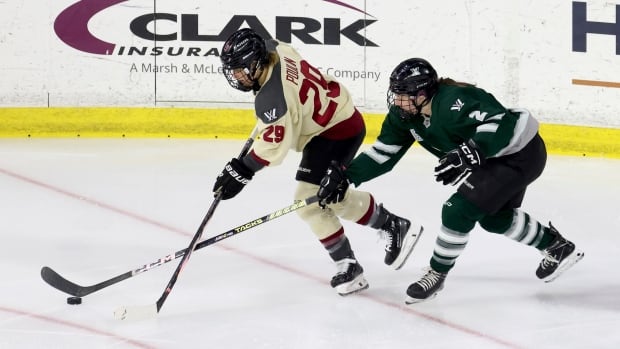The male body has long been considered the norm in sports studies, but a new resource aims to change that.
The Quebec Institute for Sport has published a new resource focused on the study of female athletes’ physiology — how their bodies work — that it hopes will improve the experiences of women in sport.
It was prepared in collaboration with sports advocacy group Egale Action, whose director of gender equality, Sylvie Beliveau, said the document was the first of its kind in the canton.
It is designed to help coaches, parents and athletes better understand the specific physiological challenges women face during competition.
“All of the coach education programs I’ve attended have been neutral in terms of the information provided, but they were based on male physiology,” Beliveau said.
Former Olympian Maxime Dufour-Lapointe races in the women’s moguls qualifying event at the 2017 FIS Freestyle Ski World Cup in Calgary, Alberta, in 2017. Now a medical trainee, Dufour-Lapointe said she’s glad research on female athletes’ bodies is getting more attention. (Todd Collor/The Canadian Press)
Beliveau said that as a coach, she spent hours translating the data she collected about men into a form that women could use, a struggle that inspired her to spearhead the publication of this new resource.
“Growth and maturity do not happen at the same time. [rate] As boys, we often compare ourselves. [boys and girls] That’s the problem. So if I’m a girls’ coach, I need to understand what happens at 10, 11, 12 years old.”
The 30-page pamphlet covers topics such as puberty, the menstrual cycle, pregnancy and birth control, and also has a section on transgender athletes.
Beliveau said Egale Action’s research had found that girls are much more likely to quit sport around puberty than boys, pointing to what he called “silent withdrawal” because they don’t give reasons.
She believes part of the reason is a gap in understanding about female physiology.
Playing catch-up in women’s sport research
François Biezen, head of the institute’s sports science department, said they have been working on the resource for about three years.
It’s only in the last decade or so that women-specific sports science research has begun to be taken seriously around the world, he says, citing the U.S., Norway and parts of France as leaders in the field, adding that Canada and Quebec are now on board as well.
“There’s a lot of work to be done to inform and educate,” he said.
Buzen said the pamphlet will be useful for coaches as well as players.
Maxime Dufour-Lapointe is an ambassador for the Quebec Sport Institute and the Association for Gender Equality in Sport’s new brochure. (Cécile Gouraud/Radio-Canada)
“[Many women] “Athletes don’t know exactly what their physiology is,” Beuzen said, “so if athletes can learn more about it and feel more confident and confident sharing that with their coaches, other athletes, doctors, etc., that would be a big step forward.”
Maxime Dufour-Lapointe, a former Olympic skier and now resident family physician, has been brought in by the institute to be an ambassador for the brochure.
“It always takes a little while for the science to catch up with what we’ve already figured out on the ground, so this is really significant,” she said.
“Some coaches were already aware of this, but not the majority. And the overall goal of this is performance, of course, but also developing the athlete as a person.”
The brochure is available free of charge on the INS website. It is currently only available in French.

